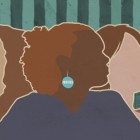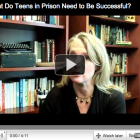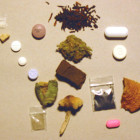
OP-ED: What About the Girls?
|
Adolescent girls are getting into trouble with the law at a rate much higher than their mothers' generation or even that of their older sisters.
Juvenile Justice Information Exchange (https://jjie.org/tag/girls/page/3/)

Adolescent girls are getting into trouble with the law at a rate much higher than their mothers' generation or even that of their older sisters.

A Florida program created in 1985 for girls who had a brush with the law has now developed into a highly successful intervention program.
PACE Center for Girls was called "the most effective program in the nation for keeping adolescent girls out of the juvenile justice system” by the Annie E. Casey Foundation in its 2008 Kids Count report.

When Crystal Contreras was seven and living in Los Angeles, her mother put her in the care of someone Contreras saw as a father figure. Instead, he pressured the little girl for sex. For the next three years, until she was 10, the man raped her regularly, often creeping into the house at night without her mother’s knowledge. “I never said nothing to my mom,” Contreras told JJIE.org during an interview in July. “I was scared he would kill her or hurt her or hurt the animals that I had.

A pair of new scholarly articles say nominally neutral rules in the juvenile justice system can actually fail girls, especially, emphasizes one author, young women of color. Discrimination is sort of hidden, said Professor Francine Sherman, director of the Juvenile Rights Advocacy Project at Boston College Law School and author of the paper “Justice for Girls: Are We Making Progress?”
“If there were laws on the books that said we’re going to do one thing for girls and another thing for boys, that would be challengeable” in court, she said. Instead, the discrimination is in practice, where “we do one thing for girls and one thing for boys.”
For example, in some states minors are still subject to criminal prostitution charges, a charge that disproportionately falls on females, and can make them less likely to run away from their exploiters. Both Sherman and a colleague point out that girls are more likely than boys to be locked up for the status violation of running away. “Most of the girls are running away from abuse,” said Jyoti Nanda, author of “Blind Discretion: Girls of Color and Delinquency in the Juvenile Justice System” and core faculty member in both the David J. Epstein Public Interest Law Program and the Critical Race Studies Program at the University of California Los Angeles School of Law.

A report released this month takes an in-depth look at how girls are represented in North Carolina's juvenile justice system, how the numbers have shifted over the years and why females are the fastest growing segment of the juvenile justice system despite the overall decrease in juvenile crime. Representing Girls In the Juvenile Justice System, released by the North Carolina Office of the Juvenile Defender, looks at not only the characteristics and risk factors of girls in the juvenile justice system, but also offers several best practices to best serve the unique issues this population faces. Since the early 1990s, due to policy changes, the number of girls in the juvenile justice system has been on the rise. Basically, the increased amount of girls in the juvenile justice system can be credited to the “relabeling of girls’ family conflicts as violent offenses, shifting police practices concerning domestic violence, processing of misdemeanor cases in a gender-biased manner and a misunderstanding of girls’ developmental issues,” according to the report. Currently, it’s estimated that girls make up 30% of youth arrested and 24% of youth serving time in detention centers. Studies show that girls are more likely than boys to be placed in these centers for less serious offenses.

About 80 percent of girls accused of misdemeanors in Maryland were committed to residential treatment centers compared to 50 percent of boys, according to statistics from Maryland’s Department of Juvenile Services (DJS). The statistics, part of the Female Offenders Report, show more than two-thirds of girls sent to residential treatment centers were committed for offenses such as fighting and shoplifting or for drug offenses. “That disparity between boys and girls is troubling and quite large," Juvenile Services Secretary Sam Abed told Capital News Service. "It's something I'm concerned about. It's a very complicated question, but it's something that merits explanation.”
The Maryland Legislature in 2011 passed a law requiring DJS to provide statistics breaking down services for boys and girls.

My Best Friend Foundation offers a grant to school superintendents and school principals. The program’s message is to reject premarital sex, underage drinking and drugs. The school district must require a long-term commitment to kids from sixth grade through high school graduation. This program is only for girls. Every year, each participant requires at least 110 hours of guidance and activities.

Imagine being ripped from your safe, normal professional life and thrust into federal prison for a year, for something stupid you did when you were a teenager, or even a young adult.
Piper Kerman doesn't have to imagine it, because that's exactly what happened to her. She was locked up in a federal prison at age 34 for a drug crime she committed in her early 20s. Because Kerman spent a year living in close quarters with many women, including 18- and 19-year-old girls, she has an unusual, nearly first-hand perspective on what teens in prison need to be successful. Here's her suggestions about what they need:
Positive attention. Kerman found the teens in particular were incredibly responsive to positive attention, creating significant opportunities for change -- opportunities that were often missed.
Girls who are bullied are at higher risk of substance abuse resulting from depression, according to a new study by Jeremy Luk at the University of Washington. Research had previously shown that both boys and girls who are victims of bullying may suffer from depression, but Luk’s research is the first to identify the link between victimization and substance abuse in girls. Luk says, “If your daughter is a victim of bullying, take it seriously, do all possible to prevent recurrence, and attend to possible depression and substance use.” His findings appear in the December issue of Prevention Science. The full text of the study is only available with a subscription but you can read more at sciencedaily.com.

A new study shows teen girls may use drugs in an attempt to form a stronger bond with their parents, particularly their fathers. Because interpersonal relationships are more important for girls it is harder for them to understand when relationships with parents deteriorate due to lack of emotional involvement. As a result the girl may feel abandoned and neglected and try to rebuild the relationship by drug usage. The report from the National Council on Family Relations is called Drug Use with Parents as a Relational Strategy for Incarcerated Female Adolescents.